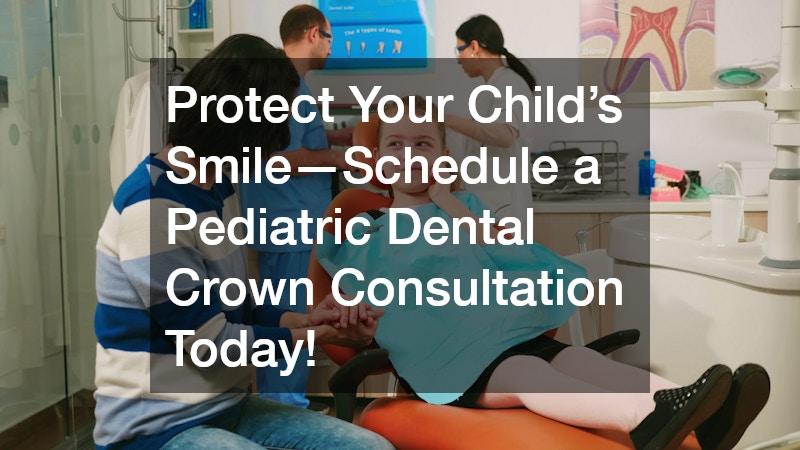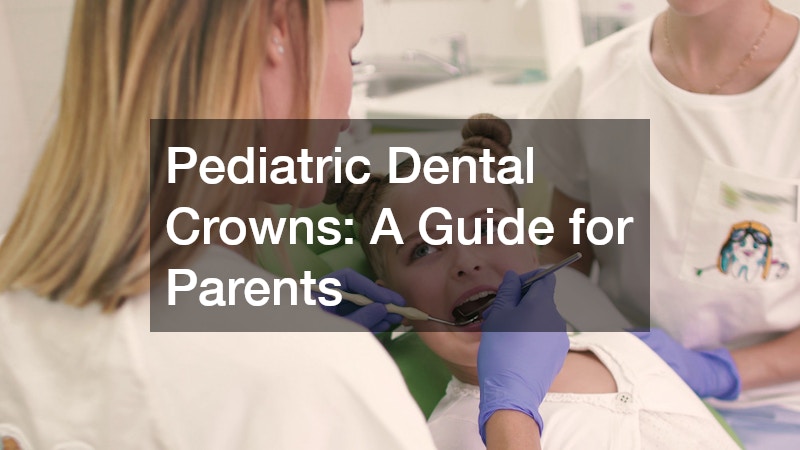
Healthy teeth are vital for a child’s development, speech, and confidence. While baby teeth eventually fall out, they still serve an important purpose—holding space for permanent teeth and aiding in proper chewing and speech formation. When decay or injury damages a tooth, a dental crown can help restore its strength and function. For many children, dental crowns offer protection that prevents future complications and maintains oral health until adult teeth are ready to emerge.
What Are Pediatric Dental Crowns?
Definition and Purpose
A pediatric dental crown is a tooth-shaped cap that covers and protects a damaged or decayed tooth. Unlike fillings, which treat small cavities, crowns are used when a tooth has lost too much structure to support a simple repair. The main goal of a dental crown is to restore the tooth’s shape, size, and function while preventing further decay or fracture.
Crowns allow children to chew comfortably and maintain proper tooth alignment during growth.
Types of Crowns Available
Pediatric dentists use several types of dental crowns, each with specific advantages depending on a child’s needs:
- Stainless Steel Crowns: Commonly used on back teeth, these crowns are durable, affordable, and can withstand chewing pressure. They’re a reliable choice for primary molars that will eventually fall out.
- Zirconia Crowns: Known for their tooth-colored appearance, zirconia crowns are often chosen for front teeth or visible areas. They provide both strength and a natural look.
- Resin Crowns: Made from composite materials, these crowns can blend well with surrounding teeth but may not be as long-lasting as metal or zirconia options.
- Strip Crowns: These are clear shells filled with composite resin and used mainly for front baby teeth that need cosmetic restoration.
How They Differ from Adult Crowns
While both types serve the same purpose—protecting and restoring teeth—pediatric dental crowns are designed with children’s developing mouths in mind. They’re typically pre-fabricated in standard sizes, allowing for quicker placement and fewer dental visits. Since baby teeth eventually fall out, pediatric crowns focus on providing functional protection for a temporary period, whereas adult crowns are custom-made for long-term durability.
When Is a Dental Crown Needed for a Child?
Common Scenarios and Conditions
Children may need a dental crown when tooth decay or injury has compromised the structure of a tooth beyond what a filling can fix. Cavities that extend deep into the tooth, fractures from accidents, or developmental defects that weaken enamel are all common reasons. In some cases, crowns are also used after a baby root canal to protect the treated tooth.
Signs Your Child Might Need a Crown
Parents should look out for symptoms such as:
- Persistent tooth pain or sensitivity
- Visible dark spots or large cavities
- Cracked or broken teeth
- Swelling or gum irritation around a specific tooth
- If your child experiences any of these, a visit to the dentist can determine whether a dental crown is the right solution.
The Impact of Dental Cavities and Trauma
Tooth decay and trauma are two leading causes of dental crown placement in children. Cavities can spread quickly in baby teeth due to thinner enamel, and untreated decay can reach the nerve, causing pain or infection. Similarly, a fall or blow to the mouth can chip or break a tooth, leaving it vulnerable. In these cases, a dental crown not only restores the appearance of the tooth but also prevents further damage and discomfort.
What Is the Procedure for Getting a Pediatric Crown?
Initial Consultation and Assessment
During the first appointment, the pediatric dentist examines the affected tooth using X-rays to assess the extent of the damage. If a dental crown is necessary, the dentist explains the treatment plan and discusses material options with the parent. For anxious children, sedation or nitrous oxide may be offered to make the experience more comfortable.
The Crown Placement Process
The process is typically completed in one visit. First, the dentist removes decay and shapes the tooth to fit the crown. The chosen dental crown—whether stainless steel, zirconia, or another material—is then fitted and cemented into place. The goal is to ensure the crown feels natural and allows for normal biting and chewing. For primary teeth, the crown will stay in place until the tooth naturally falls out.
Post-Procedure Care
After placement, it’s normal for the area to feel sensitive for a day or two. Parents should encourage gentle brushing and flossing around the crown and avoid sticky or hard foods that could loosen it. Regular dental checkups are essential to monitor the crown’s condition and the health of the surrounding teeth. With proper care, a dental crown can last until the baby tooth naturally exfoliates.
Are There Risks or Complications with Pediatric Crowns?
Potential Risks Involved
As with any dental procedure, there are potential risks. A dental crown can sometimes become loose or fall off if the cement weakens or if the tooth underneath continues to decay. In rare cases, a child may experience sensitivity or discomfort after placement.
How to Minimize Complications
Parents can help reduce risks by maintaining good oral hygiene habits at home. Brushing twice daily with fluoride toothpaste, limiting sugary snacks, and scheduling regular cleanings all contribute to the success of a dental crown. Avoiding habits like chewing on ice or hard candies also helps protect the restoration.
Signs of Complications
If a child experiences pain, swelling, or visible damage to the crown, it’s important to schedule a dental visit right away. These symptoms might indicate that the dental crown needs adjustment or replacement. Prompt attention prevents further discomfort or infection.
A pediatric dental crown can make a remarkable difference in preserving a child’s oral health and confidence. It protects weakened teeth, restores normal function, and prevents future dental issues from developing. For parents, understanding when and why a dental crown is needed helps in making informed choices about their child’s care. With regular checkups and proper hygiene, crowns can safeguard a child’s smile until permanent teeth take their place—keeping every laugh, word, and bite as natural as it should be.

